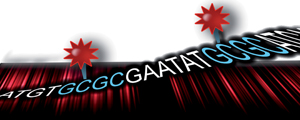A new, fast way to analyse DNA has been developed by European scientists that could be used to sequence the genomes of viruses and in the future help tackle genetic disorders such as schizophrenia and congenital heart defects.
Current DNA sequencing methods are able to sequence short regions of the genome (302 to 15002 bases in length). Regions that are either duplicated or deleted relative to a reference genome are an important cause of structural variation in the human genome with links to a variety of genetic disorders. Using current sequencing methods, studying these repeats is time consuming and labour intensive.
Now, Robert Neely and colleagues, at Catholic University Leuven, Belgium, have used a DNA methyltransferase enzyme to label the 5′-GCGC-3′ DNA sequences with a fluorescent marker. Immobilising and stretching the DNA on a surface then produces a unique and reproducible pattern when combined with the fluorescent markers. The result is a ‘fluorocode’ – a simple description of the DNA sequence, which can be read and analyzed like a barcode.
DNA barcodes using fluorescent tagging can be read quickly as labelled samples pass a detector, but Neely’s fluorocode gives significantly enhanced resolution and uses a much smaller number of DNA molecules. ‘The method from unlabelled DNA to fluorocode can be achieved in less than 8 hours for a DNA molecule that is around 50000 bases in length,’ says Neely. Current single molecule mapping methods have a timeframe of around one week for analysing individual genomes.
Kalim Mir, an expert in DNA sequencing and genomics at the Wellcome Trust Centre for Human Genetics, University of Oxford, comments, ‘the advantage the system has over conventional optical mapping is that it can provide ultra-high density mapping of genomic DNA and could easily be extended to much longer fragments from larger genomes, from bacteria to humans. The most significant challenge the authors face is to scale the technique up to the human genome.’
The group now plan to scale the fluorocode up from viral genomes to bacterial and on to eukaryotic genomes with the immediate aim of producing multi-coloured fluorocodes with even more detail.
Carl Saxton
Find out more in the Chemical Science Edge article.











